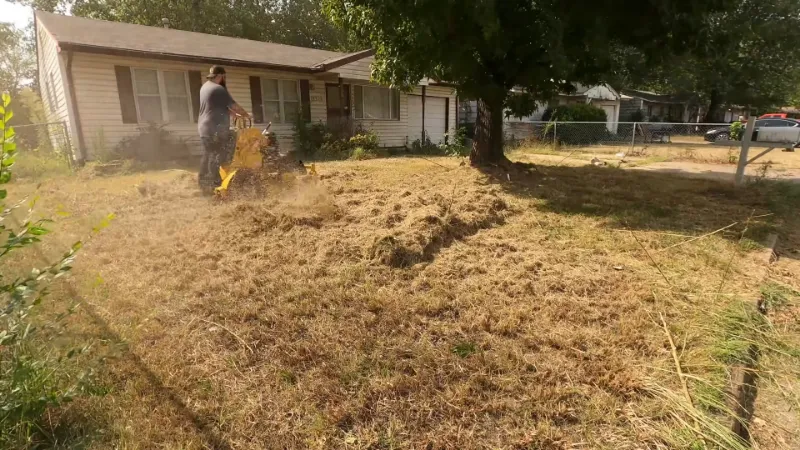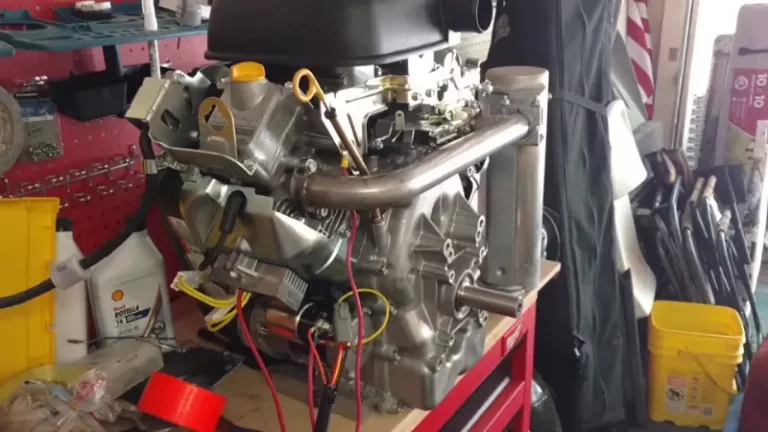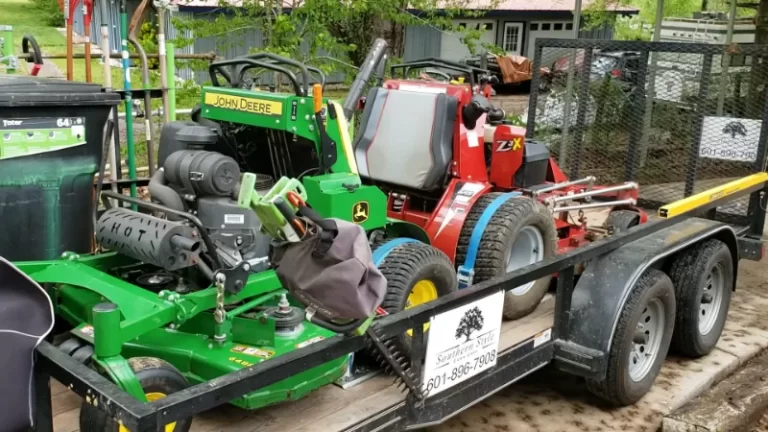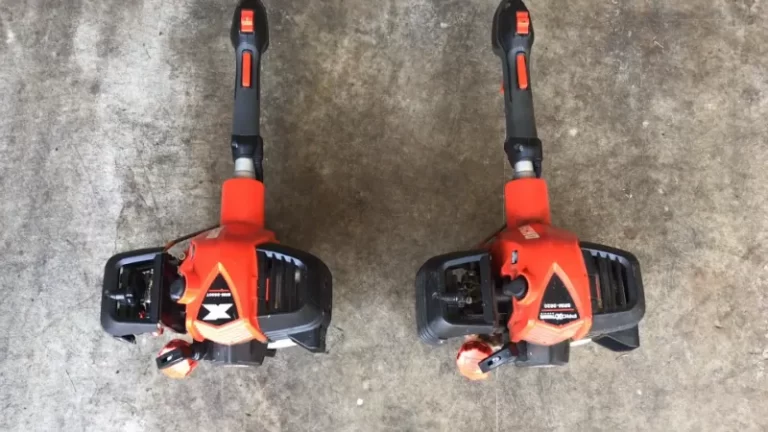Is Mowing in 100 Degree Weather Okay?

Mowing your lawn is an essential part of keeping your yard looking neat and tidy. However, when the temperature rises to 100 degrees, mowing can become a daunting and challenging task. In this article, we will discuss the importance of maintaining your lawn, the factors to consider when mowing, and some tips to help you stay safe and healthy while mowing in extreme heat.
So, let’s get started!
When is It Too Hot to Mow Your Lawn?
Mowing your lawn is an important aspect of maintaining your property’s curb appeal, but it’s essential to be mindful of the weather conditions when doing so. Extreme temperatures can be harmful to your lawn and your own health, which makes it important to know when it is too hot to mow your lawn.
The impact of high temperatures on grass During high-temperature days, the heat can cause stress to your grass. If you mow during these times, you can end up injuring your lawn and potentially killing the grass. In addition, the high temperatures can make your grass more susceptible to diseases and pests, which can cause long-term damage.
Signs of heat stress in grass There are a few signs that can indicate when your grass is suffering from heat stress. Brown or yellow spots on your lawn, dry and brittle blades, and a decrease in growth rate are all indicators that your lawn is experiencing heat stress. Mowing during this time can cause further damage, and the grass will take longer to recover from any harm.
Experts’ recommendations on mowing in hot weather It’s recommended to avoid mowing your lawn during the hottest times of the day, which is usually between 10 AM and 3 PM. Early morning or late afternoon is a better time to mow your lawn.
Additionally, it’s important to stay hydrated and wear protective clothing, including a hat and sunscreen. If you start to feel dizzy or lightheaded, take a break and rest.
In conclusion, mowing in 100-degree weather can be harmful to your lawn and your own health. High temperatures can cause heat stress to your grass, which can lead to long-term damage if you mow during this time.
The best approach is to mow during the cooler parts of the day and take appropriate precautions to ensure your safety. By being mindful of the weather conditions, you can maintain a healthy and vibrant lawn throughout the year.
Tips for Mowing in 100-degree Weather
Mowing your lawn in 100-degree weather can be a challenging task. However, with proper planning and execution, you can ensure that your lawn remains healthy and well-maintained. Here are some tips for mowing in 100-degree weather:
Time of Day to Mow
The best time to mow your lawn is in the early morning or late evening when temperatures are cooler. Mowing in the heat of the day can be dangerous, as the combination of high temperatures and physical exertion can lead to heat exhaustion or heat stroke.
Mowing Height and Frequency
During hot weather, you should raise the cutting height of your lawnmower to avoid damaging the grass. Taller grass can also provide more shade for the soil, which helps to retain moisture. You may also need to adjust your mowing frequency, as grass may grow more slowly in hot, dry conditions.
Proper Mowing Techniques
When mowing in hot weather, it’s important to use proper mowing techniques to avoid damaging the grass. Make sure your lawnmower blades are sharp, as dull blades can shred the grass and cause it to dry out more quickly. Also, avoid mowing in the same direction every time, as this can cause the grass to become compacted and reduce its ability to absorb water.
Hydration and Sun Protection
It’s essential to stay hydrated when mowing in hot weather. Drink plenty of water before, during, and after mowing to prevent dehydration. You should also wear lightweight, breathable clothing and a hat to protect yourself from the sun’s harmful UV rays.
Applying sunscreen can also help to prevent sunburn and heat exhaustion.
In summary, mowing your lawn in 100-degree weather requires careful planning and execution. By mowing at the right time of day, adjusting the cutting height and frequency, using proper mowing techniques, and taking steps to stay hydrated and protect yourself from the sun, you can keep your lawn healthy and well-maintained.
How Should You Mow Grass High Weather?
| Type of grass | Ideal mowing height in hot weather | Explanation |
|---|---|---|
| Bermuda grass | 1-2 inches | A lower mowing height encourages more lateral growth and creates a denser turf, which can help the grass retain moisture. However, cutting too low can stress the grass and make it more susceptible to damage. |
| Zoysia grass | 1-2 inches | Like Bermuda grass, a lower mowing height encourages lateral growth and helps the grass retain moisture. However, Zoysia grass can be sensitive to scalping, so it’s important to not cut it too short. |
| St. Augustine grass | 3-4 inches | A higher mowing height helps protect the soil from the sun and allows the grass to retain moisture. Additionally, St. Augustine grass has a shallow root system, so a higher mowing height can help it establish a stronger root system. |
| Kentucky bluegrass | 2-3 inches | A slightly higher mowing height can help Kentucky bluegrass retain moisture and protect the soil from the sun. Additionally, cutting the grass too short can increase the risk of heat stress and damage. |
Potential Risks of Mowing in Hot Weather
Mowing the lawn in hot weather can be risky not only for the grass, but also for the person operating the mower. Here are some potential risks to be aware of:
The Impact of Mower Equipment on Grass
Mower equipment generates a lot of heat, especially in high temperatures. If the grass is already stressed by heat, mowing can further damage it. Hot temperatures can cause the grass to lose moisture and become brittle, making it more susceptible to breakage.
The heat generated by the mower blades can also scorch the grass blades, creating brown patches. To minimize the impact of the mower on the grass, it’s important to follow proper mowing techniques, such as mowing at the right height, using sharp blades, and avoiding mowing when the grass is wet.
Risk of Heat Stroke and Dehydration
Mowing in 100-degree weather can be physically demanding and cause heat-related illnesses such as heat stroke and dehydration. Heat stroke occurs when the body’s temperature regulation system fails and the body temperature rises to dangerous levels.
Symptoms include dizziness, confusion, nausea, and a rapid pulse. Dehydration can also occur when the body loses more fluids than it takes in. Symptoms include dry mouth, dark urine, and fatigue. To prevent heat stroke and dehydration, it’s important to stay hydrated by drinking plenty of water and taking breaks in the shade.
Wear light-colored, loose-fitting clothing and a hat to protect yourself from the sun.
In summary, mowing in 100-degree weather can put both the grass and the mower operator at risk. It’s important to take precautions such as following proper mowing techniques, mowing at the right time of day, and staying hydrated to minimize these risks. If possible, it may be best to postpone mowing until temperatures are more moderate.
Alternatives to Mowing in 100-degree Weather
Mowing your lawn is an essential part of lawn maintenance, but it’s not always possible to do so, especially in 100-degree weather. However, there are still ways to keep your lawn looking healthy and well-maintained without mowing.
Watering Your Lawn
One of the best ways to keep your lawn healthy in hot weather is to water it. A well-watered lawn can withstand heat stress better than a dry lawn. Water your lawn early in the morning before the sun is up and the temperature starts to rise.
This will ensure that the water has time to soak into the soil before it evaporates.
Using Shade to Protect Your Lawn
If your lawn is in an area that receives direct sunlight, you can protect it from the sun’s heat by using shade. Planting trees or installing awnings or other types of shade can help to reduce the temperature of your lawn and protect it from heat stress.
Hiring a Professional Lawn Care Service
If mowing your lawn in 100-degree weather is not an option, you can hire a professional lawn care service to do it for you. Professional lawn care services have the equipment and expertise to maintain your lawn in hot weather. They can also provide additional services like watering and fertilizing to keep your lawn healthy and thriving.
In conclusion, mowing your lawn in 100-degree weather can be risky for both your lawn and your health. However, there are still ways to maintain your lawn without mowing, such as watering your lawn, using shade, and hiring a professional lawn care service. By taking these steps, you can keep your lawn looking healthy and well-maintained, even in the hottest of temperatures.
Additional Tips
Here are a few additional tips to consider when mowing in 100-degree weather:
Use a Self-propelled Mower
Using a self-propelled mower will help you avoid overexerting yourself, and it will also help you maintain a consistent mowing speed. This is particularly important in hot weather, as you want to avoid running out of energy or getting fatigued.
Take Breaks
It’s essential to take breaks frequently, particularly if you’re feeling hot or lightheaded. If possible, mow early in the morning or later in the evening, when the temperatures are cooler. Alternatively, break up your mowing into shorter sessions with plenty of rest in between.
Maintain Your Mower
Make sure your mower is in good working order before you start mowing. Check the blades, spark plugs, and air filter, and replace them as needed. Keeping your mower in good condition will ensure that it works efficiently and won’t overheat in the hot weather.
Dress Appropriately
Wear light, loose-fitting clothing that covers your skin and provides good ventilation. A hat and sunglasses can also help protect your face and eyes from the sun.
Stay Aware of Your Body
Pay attention to your body and be mindful of any signs of heat exhaustion or heat stroke. If you feel dizzy, nauseous, or have a headache, take a break and cool down. If you experience more severe symptoms such as confusion, rapid heartbeat, or fainting, seek medical attention immediately.
By following these additional tips, you can ensure that you mow your lawn safely and effectively, even in hot weather. Remember, it’s crucial to take care of your lawn, but it’s equally essential to take care of yourself.
Frequently Asked Questions
Can Mowing in 100-degree Weather Cause Permanent Damage to My Lawn?
Mowing in 100-degree weather can cause permanent damage to your lawn, particularly if the grass is already stressed or weakened by the heat. Mowing during high temperatures can lead to scalping or cutting the grass too short, which exposes the roots to direct sunlight and causes the grass to dry out faster.
This, in turn, can lead to brown patches and dead spots in your lawn. To prevent permanent damage, it’s important to mow during the cooler times of day, adjust the mowing height and frequency, and use proper mowing techniques.
What Type of Lawn Mower is Best for Mowing in Hot Weather?
The type of lawn mower you use can impact your ability to mow in hot weather. Electric mowers are generally better for mowing in high temperatures than gas-powered mowers because they don’t emit hot air, which can dry out your lawn even more.
Additionally, self-propelled mowers can make the mowing process easier on you, as you won’t have to exert as much physical effort in the heat.
How Can I Tell if My Grass is Suffering From Heat Stress?
There are several signs that your grass is suffering from heat stress. These include wilting, yellowing, and browning of the blades, as well as a general lack of vigor and growth. Additionally, if you walk on your grass and it doesn’t bounce back up, it may be dehydrated and stressed.
Is It Safe to Mow in the Early Morning or Evening When It’s Cooler?
Yes, mowing during the cooler times of day, such as the early morning or evening, can be safe and effective in hot weather. During these times, the grass is less likely to be stressed and dehydrated, and you’re less likely to overheat or suffer from heat stroke.
However, it’s important to still take precautions such as wearing sun protection and staying hydrated.
Can I Water My Lawn Instead of Mowing in 100-degree Weather?
Yes, watering your lawn can be a good alternative to mowing in extremely hot weather. By watering during the early morning or evening, you can help keep your grass hydrated and prevent heat stress. However, it’s important not to overwater, as this can lead to fungal growth and other issues.
Additionally, be sure to adjust your watering schedule based on local water regulations and drought conditions.
Closing Thoughts
Maintaining a healthy lawn requires proper care and attention, especially during hot weather conditions. Mowing in 100-degree weather can be risky for both your lawn and your health. It is essential to consider the potential risks, proper techniques, and alternatives to mowing in such conditions.
Watering your lawn and providing shade can help keep your lawn healthy without causing damage. If you must mow in hot weather, it is best to do so during the cooler parts of the day, maintain a higher mowing height, and take proper precautions such as staying hydrated and protecting yourself from the sun.
Remember that a healthy lawn not only adds to the beauty of your home but also has numerous environmental benefits. By following the recommendations outlined in this article, you can keep your lawn healthy and thriving, even in the hottest weather.

![Exmark Metro 26 Review [Is It a Good Option?]](https://fixitinthehome.com/wp-content/uploads/2023/02/Exmark-Metro-26-768x432.webp)




![Benefits of Mixing Cedar and Pressure Treated Wood [Mix Properly]](https://fixitinthehome.com/wp-content/uploads/2023/02/Mixing-Cedar-and-Pressure-Treated-Wood-768x432.webp)